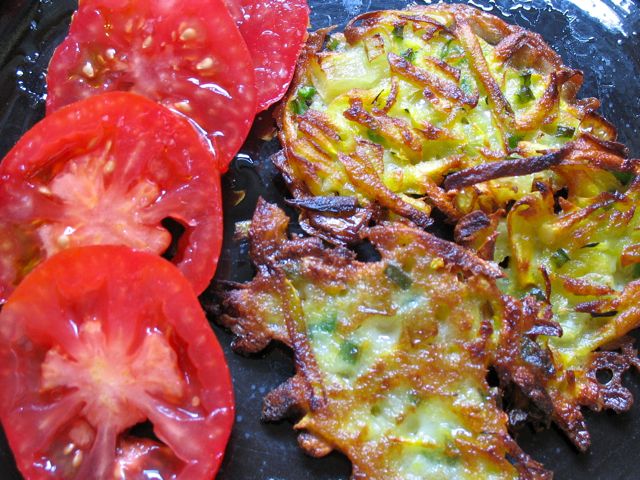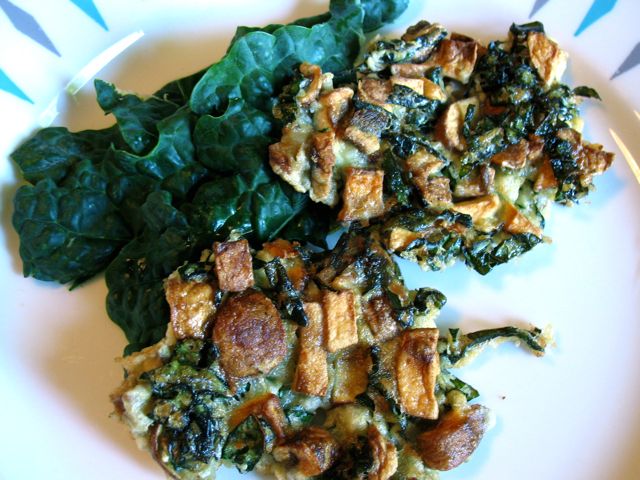
reference-image, l
(article, Kelly Myers)
In September I gave fritters of corn and zucchini to anyone who happened to wander through the King Farmers' Market, in Portland, Oregon. I was cooking at this new farmers' market as part of Market Chefs, an organization I started to inspire and teach people about cooking fresh, local food — like that found at farmers' markets. [[block(sidebar). h1.Featured recipe]] As I flipped fritters at a two-burner stove, market shoppers stopped to watch and snatch up the crisp little vegetable pancakes. Afterward, they took copies of the recipe, asked questions — "What's the deal with eggplant? Why and when do you salt it?" — and even shared stories (a memory of collard greens served with grated coconut in the Philippines). I could not have asked for a better way to show off the vegetables of late summer. The fritters were sweet, rich-tasting, and lacy-crisp at the edges. [%image reference-image float=right width=400 caption="Squash-and-pepper fritters, with tomatoes on the side."] Vegetable fritters resemble potato latkes, with small amounts of a light batter holding together bits of diced or grated vegetable. Unlike latkes, however, fritters don’t require much oil to fry up crisp — less than a quarter-inch in a wide skillet. Fritters have other qualities to recommend them. Because they look like pancakes, children will generally eat them. The batter requires zero technique. And unlike other batters, there are no egg whites to whip or fold. This batter is not a coating; it’s only there to hold the vegetables together. After all, in this preparation the vegetables are the star. So if you still have corn and zucchini, turn them into fritters — quick! It's OK if the late-season corn is a little starchy. The kernels will caramelize in the skillet, creating a deep flavor that will make you forget about the starch. Serve the fritters with Greek yogurt spiked with cumin, or with tomato sauce, chutney, or a fresh salsa. But it’s October. Unending solar warmth is already a memory. Corn and zucchini are pretty much gone from farmers' markets. I have wondered what kind of fritters I can make for fall. The season holds the answer. The market now is like a bridge between summer and deep, foggy fall. Piles of sun-fueled peppers sit next to the hard winter squashes that will be with us for some time. Check out the shoulder-season peppers. I don’t mean the sweet bell peppers so much, although they are delicious. It’s the Gypsys, Italian frying peppers, hot peppers, hatch peppers, and Anaheim peppers that can provide a refreshing foil to the sweet orange squashes. My new favorite fritter is made of grated delicata squash mixed with bits of jalapeño and Gypsy peppers. They are sweet and spicy, with a slight bracing quality. [%image fritters float=right width=400 caption="Mushroom and kale fritters."] Delicatas are the first winter squashes to sweeten. There’s no need to peel the delicata’s thin skin. Just cut the squash in half lengthwise, scoop out the seeds, and grate it on the largest holes of a standard box grater. Add diced peppers, batter, and fry. Serve them with a sliced and salted tomato, and you’ve got a nice lunch, side dish, or component of brunch. Imagine fritters with a fried egg on top. The fall chanterelle-mushroom season is here, too, and their prices have been relatively low. I’m dreaming of chanterelle fritters with warm tomato sauce and some Parmesan cheese. When it gets colder, markets will feature other good fritter candidates. Root vegetables like parsnips and celery root will be sweet and complex. The prospect of sweet potatoes from Ayers Creek Farm in Gaston, Oregon, holds great promise. I’m thinking about sweet-potato fritters with bits of boiled chicory in them. Just keep a few points of technique in mind: # The vegetables need to be in small pieces, either diced, grated, or pulverized in a food processor. # The cooking fat should be hot, almost smoking, so the fritters don’t soak up oil and get soggy. # Once you (carefully) drop a couple of tablespoons of batter into the skillet, flatten it with the back of a fork. This exposes more of the vegetable’s cut surfaces to the hot fat and creates a crisp texture. # Fry the fritters for about two minutes per side, or until the fritters are golden brown. A quick blot on paper towels and the fritters are ready to go. Serve them piping hot, just like pancakes. p(bio). Kelly Myers is a chef and writer in Portland, Oregon. She is also the co-director of Market Chefs, an organization dedicated to inspiring and teaching consumers to cook local foods.

reference-image, l

fritters, l